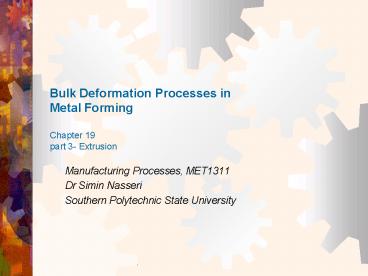Bulk Deformation Processes in Metal Forming Chapter 19 part 3- Extrusion - PowerPoint PPT Presentation
1 / 15
Title:
Bulk Deformation Processes in Metal Forming Chapter 19 part 3- Extrusion
Description:
part 3- Extrusion Manufacturing ... to Forging Extrusion Wire and Bar Drawing Extrusion Compression forming process in which work metal is forced to flow through a ... – PowerPoint PPT presentation
Number of Views:704
Avg rating:3.0/5.0
Title: Bulk Deformation Processes in Metal Forming Chapter 19 part 3- Extrusion
1
Bulk Deformation Processes in Metal
FormingChapter 19part 3- Extrusion
- Manufacturing Processes, MET1311
- Dr Simin Nasseri
- Southern Polytechnic State University
2
BULK DEFORMATION PROCESSES IN METALWORKING
- Rolling
- Other Deformation Processes Related to Rolling
- Forging
- Other Deformation Processes Related to Forging
- Extrusion
- Wire and Bar Drawing
3
Extrusion
- Compression forming process in which work metal
is forced to flow through a die opening to
produce a desired cross-sectional shape - Process is similar to squeezing toothpaste out of
a toothpaste tube - In general, extrusion is used to produce long
parts of uniform cross sections - Two basic types
- Direct extrusion (Forward extrusion Metal flows
in direction of Ram movement) - Indirect extrusion (Backward extrusion Metal
flows in opposite direction of Ram movement)
4
Advantages of Extrusion
- Variety of shapes possible, especially in hot
extrusion - Limitation part cross section must be uniform
throughout length - Grain structure and strength enhanced in cold and
warm extrusion - Close tolerances possible, especially in cold
extrusion - In some operations, little or no waste of
material - Examples Door/window frames, sliding door
railings, door handles, brackets, gears, etc
5
Hot vs. Cold Extrusion
- Hot extrusion - prior heating of billet to above
its recrystallization temperature - Reduces strength and increases ductility of the
metal, - permitting more size reductions and
- more complex shapes
- Cold extrusion - generally used to produce
discrete parts - The term impact extrusion is used to indicate
high speed cold extrusion
6
Common extrusion shapes
7
Direct Extrusion
- Also called forward extrusion
- As ram approaches die opening, a small portion of
billet remains that cannot be forced through die
opening - This extra portion, called the butt, must be
separated from extrudate by cutting it just
beyond the die exit - Starting billet cross section usually round
- Final shape of extrudate is determined by die
opening
- Figure 19.30 Direct extrusion.
Ram final position
8
Example
- Have you played with a dough plunger toy before?!
9
Hollow and Semi-Hollow Shapes
- Figure 19.31 (a) Direct extrusion to produce a
hollow or semi-hollow cross sections (b) hollow
and (c) semi-hollow cross sections.
10
Indirect Extrusion
Ram forces the work billet in a closed container,
causing the work metal to flow against the
direction of the ram.
Final shape a hollow rod
Final shape a solid rod
- Figure 19.32 Indirect extrusion to produce (a) a
solid cross section and (b) a hollow cross
section.
11
Comments on Indirect Extrusion
- Also called backward extrusion and reverse
extrusion - Limitations of indirect extrusion are imposed by
- Lower rigidity of hollow ram
- Difficulty in supporting extruded product as it
exits die
12
Extrusion Ratio
- Also called the reduction ratio, it is defined as
- where rx extrusion ratio Ao
cross-sectional area of the starting billet and
Af final cross-sectional area of the extruded
section - Applies to both direct and indirect extrusion
13
Orifice Shape of Extrusion Die
- Simplest cross section shape is circular die
orifice - Shape of die orifice affects ram pressure
- As cross section becomes more complex, higher
pressure and greater force are required
14
Complex Cross Section
- Figure 19.36 A complex extruded cross section
for a heat sink (photo courtesy of Aluminum
Company of America)
15
Extrusion Presses
- Either horizontal or vertical
- Horizontal more common
- Extrusion presses - usually hydraulically driven,
which is especially suited to semi-continuous
direct extrusion of long sections - Mechanical drives - often used for cold extrusion
of individual parts































